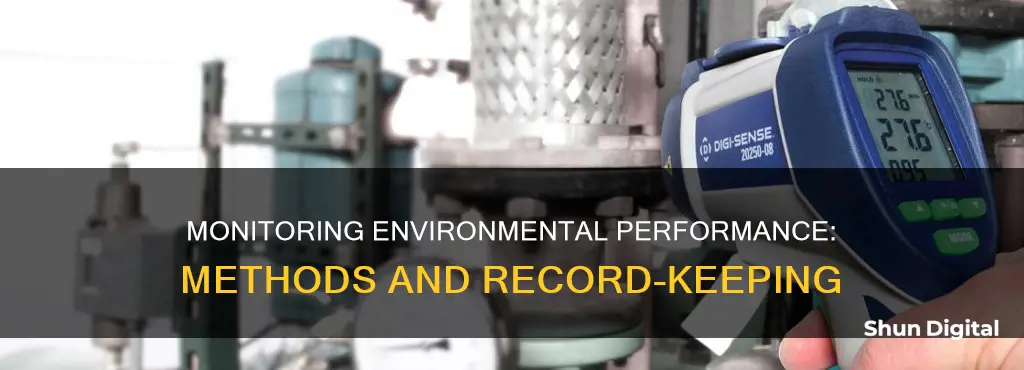
Environmental performance monitoring is a tool to assess environmental conditions and trends, support policy development and its implementation, and develop information for reporting to national policymakers, international forums, and the public. Environmental performance can be monitored through various methods, including air quality monitoring, soil monitoring, water quality monitoring, and radiation monitoring. These methods involve the use of sensors, sampling, and laboratory analysis to measure and evaluate different parameters such as air pollutants, soil health, water quality, and radiation levels. The data collected is then analyzed, interpreted, and used to make informed decisions and develop policies to improve environmental performance and sustainability.
| Characteristics | Values |
|---|---|
| Purpose | To assess environmental conditions and trends, support policy development and its implementation, and develop information for reporting to national policymakers, international forums, and the public. |
| Scope | Air quality, soil and water quality, waste generation, biodiversity, and compliance with environmental regulations. |
| Methods | In-situ representative sampling (grab sampling), laboratory analysis of samples, remote sensing, ecological sampling, etc. |
What You'll Learn

Air quality monitoring
Sensor-Based Air Quality Monitors
Sensor-based air quality monitoring systems are ideal for highly-polluted areas due to their compactness and wide applicability. These systems provide detailed spatial and temporal coverage and are continuous, low-cost, portable, and easily installed. They measure different parameters, including weather data like temperature, humidity, and pressure, and send the data to a central server for analysis and interpretation.
Continuous Ambient Air Quality Monitoring Stations (CAAQMS)
CAAQMS are air quality monitoring stations installed around cities by state or central pollution control boards. They measure pollutants such as Sulphur dioxide (SO2), Nitrogen dioxide (NO2), Ozone (O3), Carbon monoxide (CO), and particulate matter (PM2.5 and PM10). This data is archived and used for pollution-mapping and creating air quality standards.
Open-Path Monitoring Systems
Open-path monitoring systems provide the average concentration of targeted pollutants over an extended measurement path, without the need to collect samples. This method can be used for a wide variety of contaminants and provides high-precision quantification of atmospheric gases. However, it is expensive and cannot measure non-hydrocarbons or detect ground-level pollution.
Manual Air Quality Monitoring System (AAQMS)
The AAQMS, or manual sampler, draws a known volume of air through a filter, which is then analysed for different pollutants. This process can take up to 2-7 days and includes manual steps like transferring the sample to a lab and generating a report.
Choosing the Right Air Quality Monitoring System
The primary factor in choosing an air quality monitoring system is the purpose of monitoring, which helps identify other important factors like cost, ease of use, data detection time, environmental conditions, data accuracy, and calibration frequency.
Remote Sensing
Remote sensing plays a crucial role in monitoring and reporting on environmental problems, especially when assessing pollutant effects over large spatial and temporal scales. It provides complementary information to ground-based monitoring systems and enables timely data collection and cross-boundary information.
Clearblue Fertility Monitor: Where to Buy in Australia?
You may want to see also

Water quality monitoring
Common Biological Measures:
Benthic macroinvertebrates, such as mayflies, stoneflies, and beetles, are frequently used as biological water quality indicators. They are abundant, easier to capture than fish, and easier to identify than algae or protozoans. Samples can be collected using different samplers depending on the size of the streams, and the number of organisms is estimated by counting and enumerating them. The density of these macroinvertebrates is reported as the total number per square meter of the stream bottom. Additionally, measures of diversity, especially at the taxonomic level of order, should be noted. The Shannon index and the EPT index are used to measure the diversity and quality of the invertebrate community, respectively.
Common Chemical Measures:
Chemical measures assess the presence and concentration of various elements and molecules dissolved or suspended in water. For example, pH measurements indicate the acid-base balance of water, with low pH values suggesting acidity and the possible presence of acid mine drainage. However, it's important to note that some streams are naturally acidic, so a low pH doesn't always indicate pollution. The level of nitrates, which are essential for the growth of algae and aquatic plants, is another important chemical measure. Nitrate levels can be determined by first measuring nitrite levels and then reducing nitrate to nitrite and measuring the combined concentration. Other chemical indicators include dissolved oxygen levels, which can indicate the presence of raw sewage or acid mine drainage when low.
Common Physical Measures:
Physical measures involve determining various physical characteristics of surface water within a given watershed. This includes measuring catchment area, built-up area, water temperature, air temperature, stream width, average and maximum depth, velocity, discharge, forest canopy coverage, average and maximum rock size, and water transparency. These measurements provide valuable information about the health and quality of the water body.
Sampling Methods:
Data Analysis and Interpretation:
The data collected from water quality monitoring is then analyzed and interpreted to assess the health and quality of water resources. This includes comparing the results to established standards and guidelines, such as those provided by the Environment Agency in the UK. Additionally, statistical methods may be employed to identify trends and make informed decisions about water management and protection.
Blind Spot Monitoring: Both Sides, Now
You may want to see also

Soil and land quality monitoring
- Soil Sampling: Soil sampling is a common technique used to assess soil quality. It involves collecting and analysing soil samples to determine its physical and chemical properties, such as texture, composition, and nutrient content. There are two primary types of soil sampling: grab sampling and composite sampling. Grab sampling collects individual samples at specific locations and times, while composite sampling creates a homogenised mixture of multiple samples from different locations or times.
- Soil Moisture Monitoring: Monitoring soil moisture is crucial for effective irrigation management. Direct methods, such as the feel and appearance method, rely on subjective assessments of soil moisture by trained individuals. Indirect methods use sensors and calibration equations to measure soil volumetric water content, providing more precise and instantaneous data.
- Soil Contamination Monitoring: This type of monitoring helps identify patterns and trends in the deposition, movement, and effects of contaminants in the soil. Both inorganic and organic pollutants can have detrimental effects on soil health and fitness for use. Monitoring efforts can range from local farms to nationwide initiatives, providing valuable data on the nature and extent of contamination.
- Soil Erosion Monitoring: Soil erosion monitoring focuses on identifying and quantifying soil and sediment movement. By understanding erosion patterns, researchers can assess the impact of erosion on crop productivity and soil quality.
- Soil Quality Indicators: Evaluating soil quality involves considering multiple indicators, including physical, chemical, and biological factors. Physical/chemical indicators, such as soil depth, texture, and pH, tend to be more stable over time. Biological indicators, such as microbial populations and organic matter characteristics, are highly dynamic and sensitive to changes in soil conditions.
- Land Evaluation: Land evaluation models, such as the Mediterranean Land Evaluation Information System (MicroLEIS), analyse the influence of physical indicators on critical soil functions like agricultural suitability, crop growth, and erosion resistance. This information is valuable for developing sustainable land management practices.
Chevy Colorado: Blind Spot Monitor Availability and Performance
You may want to see also

Noise level monitoring
Techniques for Noise Level Monitoring:
Sound Level Meters:
Sound level meters are commonly used to measure noise levels in the workplace and are positioned near the employee's head or at specific locations within the workplace. Multiple measurements are taken at different times and locations to estimate noise exposure over a workday. If noise levels fluctuate, appropriate averaging techniques, such as the Leq method, are used to determine the overall sound levels. Sound level meters also offer various options for signal averaging and analysis.
Dosimeters:
Dosimeters are worn by employees and provide an average noise exposure reading for a given period, such as an 8-hour workday. They store sound level measurements and integrate them over time. A microphone attached to the employee's clothing captures the noise levels they experience as they move around the workplace. Dosimeters are particularly useful when noise levels fluctuate or employees are mobile.
Smartphone Applications:
Smartphone applications, such as NoiseTube, have been developed to encourage citizen participation in noise level monitoring. These apps enable users to take noise measurements and provide a realistic assessment of human annoyance caused by noise pollution. By collecting data from a group of users, these applications can identify silent and noisy areas with greater accuracy.
Factors Affecting Noise Propagation:
It is important to consider the factors influencing sound propagation when monitoring noise levels. These factors include the source-receptor distance, topography of the area, ground-level characteristics, and meteorological conditions. Understanding these factors helps in predicting how sound levels change with distance from the noise source.
Noise Level Measurement Standards:
Different countries have their own noise level measurement standards, such as the standards prescribed by the Central Pollution Control Board (CPCB) in India. These standards help compare monitored noise levels to permissible levels and identify areas that require noise control measures. Compliance with local regulations is essential for conducting accurate and meaningful noise level assessments.
Testing Monitors Before Buying: What You Need to Know
You may want to see also

Remote sensing
- Analysis and Management of Agriculture and Forests
- Management of Water Resources
Water resource management is crucial for sustainable development, and remote sensing plays a vital role in this area. Satellites can monitor activities around water bodies, helping enforce measures to protect them. Remote sensing also aids in the detection and quantification of water pollution, facilitating the management of water quality.
- Management of Air and Water Quality
- Management of Infrastructure
- Management of Natural Resources
Natural resources like oil, coal, water, forests, and natural gas are valuable and vulnerable to theft and misuse. Remote sensing helps protect these resources by recording all activities in the environment, reducing the chances of abuse and illegal exploitation.
- Management of Natural Disasters
- Weather Prediction
- Analysis of Land Covers and Land Mapping
- Oceanography and Coastal Monitoring
- Soil Moisture Data
Soil moisture data is essential for agriculture, ecological management, and weather forecasting. Remote sensing techniques, such as NASA's Soil Moisture Active Passive (SMAP) Mission, provide valuable data on soil moisture by retrieving information from satellites.
- Vegetation Monitoring
- Urban Planning
- Environmental Study and Habitat Conservation
- Research Tool
- Disaster Management and Emergency Response
Speck Air Quality Monitor: Where to Buy?
You may want to see also
Frequently asked questions
Environmental performance monitoring involves the following key components:
- Hazard monitoring: Identifying and assessing potential hazards to the environment, such as chemical spills or air pollution.
- Exposure monitoring: Determining the extent to which people and ecosystems are exposed to these hazards.
- Health outcome monitoring: Evaluating the health impacts of environmental hazards, including both short-term and long-term effects.
- Intervention monitoring: Assessing the effectiveness of interventions or policies implemented to mitigate environmental hazards.
Common methods and tools used for environmental performance monitoring include:
- Air quality monitoring: Measuring the concentration of air pollutants, such as particulate matter, greenhouse gases, and volatile organic compounds.
- Soil monitoring: Assessing soil quality, constituents, and physical status to identify potential risks and contamination.
- Water quality monitoring: Evaluating the chemical, physical, and biological characteristics of water sources to ensure they meet environmental and health standards.
- Ecological monitoring: Studying the plants and animals in a specific environment to understand the impacts on their health and biodiversity.
- Remote sensing: Using satellite technology and aerial surveillance to monitor large areas, especially for detecting deforestation, climate change, and ocean depths.
- In-situ sampling: Collecting samples from the environment, such as air, water, or soil, and analysing them in a laboratory to identify contaminants or pollutants.
- Modelling and simulations: Employing computer models and simulations to predict and assess the impacts of environmental changes or hazards.
- Biodiversity monitoring: Tracking the number and variety of species in an ecosystem to evaluate the health and resilience of natural environments.
Environmental performance monitoring provides several benefits, including:
- Informing policy development: By understanding the current state of the environment and identifying trends, policymakers can make informed decisions to protect and improve the environment.
- Supporting sustainability: Monitoring can help organisations and countries achieve their sustainability goals, reduce costs, enhance their reputation, and comply with legal obligations.
- Identifying risks and impacts: By assessing hazards, exposures, and health outcomes, monitoring can identify risks to human health and ecosystems, enabling the implementation of preventive measures.
- Promoting transparency and accountability: Monitoring provides data and evidence that can be shared with stakeholders, the public, and policymakers, fostering transparency and accountability in environmental management.







